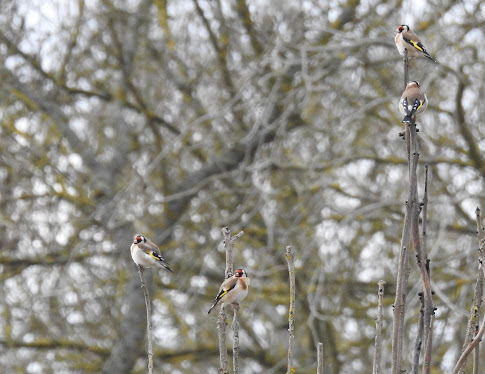A mild mainly sunny day with not much of a breeze. Positively springlike in fact. Dave and I resumed our efforts to spot the differences between this visit to the patch and the last one. It was to prove a better than average morning.
We began along the Netherstead access road where I spent some time trying, with limited success, to photograph the single Marsh Tit which was visiting the feeders. We then headed towards the flash field, seeing a pair of Bullfinches and two Stonechats on the way.
I missed a Little Egret Dave had tried to point out as it disappeared from view, but when we got to the rise which is the best place from which to view the furthest flash, my luck changed. The first Shelduck of the year was swimming on it, and after Dave had counted eight Lapwings we also spotted a drake Wigeon (another year tick) as it swam out of view. I managed a horribly blurred record shot of the former before it took flight.
 |
| The Shelduck |
The nearest flash brought us a second chance to see the Little Egret, the three Green Sandpipers seen by John C yesterday, at least 32 Teal, two more Stonechats (both males), and a Grey Heron. We were also joined by another birder, Gary Jilks, a rare event in itself.
 |
| Little Egret |
 |
| Grey Heron |
A bit of a downer was confirmation that the Kingfisher Pool has been completely drained, but it remains to be seen whether a master plan is afoot. Either way it is bad news for all the dragonfly larvae which might have expected to emerge there this summer.
We completed our visit by adding a couple of Redpolls to the list, and watching at least 19 Goldfinches which are obviously still finding enough to eat in the remains of the uncut strip.
 |
| Goldfinches |
And of course the approach of March has not gone unnoticed by the local Brown Hares.
 |
| Brown Hares |
It won't be too long before insects start to feature.
In fact, I made a late decision to stick the moth trap out in the garden last night and it paid off with an overdue garden first. The moth in question was Dark Chestnut (I caught two), and also a Chestnut, a Common Quaker (nfy), and a Pale Brindled Beauty. (Inadvertently wrote Pale Mottled Willow on earlier draft, which I just noticed)...bloody silly moth names.
 |
| Dark Chestnuts |
 |
| Dark Chestnut (left) and Chestnut |
Surprisingly, Obsidentify let me down. It couldn't come up with an identification for the Dark Chestnuts, but was quite happy to identify the Chestnut. Fortunately a perusal of the available literature and on-line images confirmed that the white dots visible on the outer edge of the forewing ruled out Chestnut.
It appears that Dark Chestnut emerge in November and fly until late February which explains why they were a bit tatty and why I hadn't seen one before.
No comments:
Post a Comment